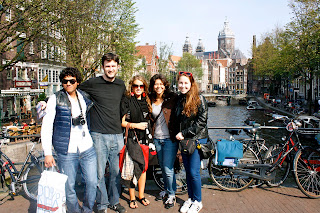
Por
Camille ValdesNortheastern University
“Sol, playa y arena vamo’ allá”.
Esto era lo único que podía pensar cuando me enteré que íbamos a las Islas Canarias. Cuando llegamos lo primero que hicimos fue ir a la playa, de lejos se veía el contraste de los azul con la arena blanca. La verdad que cuando la vi me trajo una serenidad y una paz el sonido de las olas y la belleza del horizonte. Jose María, nuestro guía, nos dijo que esa era única de las playas de arena blanca ya que la mayoría de las playas en las Islas Canarias son de arena negra por ser islas volcánicas. Para mí, estar en la playa era como estar en casa, en Puerto Rico. Toda esas semejanzas: el color del agua, la arena y el calor pero todo esa percepción cambio cuando toqué el agua, estaba completamente congelada. Ahí me di cuenta que a pesar de todas las semejanzas, no tan sólo de cómo se veía la isla sino la gente también, yo no estaba en casa. Sin embargo como ya dije la gente me recordaba bastante a como las personas hablan en casa. En algún momento me acuerdo haber dicho, que el acento de los canarios era como música para mis oídos. Lamentablemente no nos quedamos mucho tiempo en Tenerife porque había que ir a nuestro destino final, la Gomera.
Cuando llegamos a la isla de la Gomera específicamente, tuvimos un recorrido por la isla con un guía que nos hablaba de la historia de la isla y nos enseñó de donde supuestamente sacaron el agua con la cual se bautizó a las Américas. Durante este recorrido también vimos lo que era la expresión del arte gótico en la Gomera que en realidad no tenía mucho de gótico, solo la forma del arco en la entrada era lo que hacia que la iglesia formara parte de este tipo de arquitectura. Nos explicó que la razón por la cual no era lo que comúnmente pensábamos como gótico por lo lejos que se encuentra la isla de la península ibérica.
El siguiente día nos llevaron a comer a un restaurante para que probásemos comida tradicional de la Gomera. Yo juro que cuando vi la comida parte de mi pensó que lo único que me faltaba eran un poco de arroz con la carne de cerdo o unos tostones o amarillos (platano maduro) como acompañamiento. A mí pesar no teníamos esto pero sí habían papas arrugás. Estas papas son hervidas con mucha sal y luego mantener las papas en la cacerola con el fuego apagado pero para que se continúen cocinando. Luego de unos minutos las papas quedan secas y blancas por fuera por sal. Estas usualmente se comen con mojo picón pero también hay un mojo de cilantro, el cual yo probé. ¡Este mojo era riquísimo! La combinación de las papas con el mojo era increíble. Antes de la carne y las papas había una sopa que podías ponerle gofio que es una harina de maíz que los canarios le ponen pues a sopas, al café, entre otras. Me gustó mucho esta combinación, nunca hubiese pensado poner el gofio a la sopa ni al café. Usualmente en Puerto Rico, el gofio solo es un dulce de maíz que comemos durante las navidades. Para finalizar la comida, comimos un postre que se llamaba leche hervida, en esencia se parecía mucho al flan y era igual de rico también. Luego del restaurante fui por primera vez a una playa de arena negra. La verdad que es otra experiencia. La percepción de esa playa es totalmente diferente a la que siempre he pensado pero me encantó. Era algo nuevo e interesante que podía apreciar por lo diferente que era a una playa en Puerto Rico. No podía comparar y decir pues la playa de casa es mejor porque son totalmente diferentes. Para mí, era curioso mirar a mis pies y verlos negros por la arena. Hasta cierto punto si lo mirabas de lejos lo que aprecia era que tenías los pies llenos de fango.
En fin, esta excursión a la Gomera fue una experiencia que nunca olvidaré y que me hizo empezar a extrañar el habla de los caribeños y el paisaje de Puerto Rico. Como me dijo Paco, “la Gomera va ser como estar en casa” y la verdad lo fue. De hecho me siento también un poco vindicada con mis amistades de Latinoamérica porque ellos siempre me dicen que yo me invento palabras y que en ningún lugar se usan las palabras que yo uso. Pues allí en las Canarias palabras como guagua y parcha se utilizan de la misma manera que en Puerto Rico. No sabes todos los años que tuve que escuchar, “no es guagua, es bus” o “no es parcha, es maracuyá”. Yo ahora le digo a mis amistades, después de esta visita a la Gomera, que nosotros somos los que hablamos y decimos las cosas correctas porque los canarios fueron importantes en el descubrimiento y entonces cabe deducir que simplemente seguimos lo que nos enseñaron ellos.







